Record your transactions on the website using Selenium IDE and later create scripts of the recording.
Prerequisites
- Install the latest Selenium IDE extension in your preferred browser.
Install Selenium IDE extension in the browser for the first time
Follow the below steps to install Selenium IDE Extension:
- Open your preferred browser (ex: Chrome, Firefox, or Edge).
- Go to the browser’s extension/add-on store or visit the official Selenium website.
- Search for Selenium IDE.
- Select the Selenium IDE extension
- Click Install or Add to Browser to complete the installation.
Record a Transaction using Selenium IDE
After installing the Selenium IDE, start recording each action performed on a website.
After completing the recording of the transaction, Selenium IDE reviews each recorded action and saves the recording to the location.
Start Recording
Start recording the transaction using the Selenium IDE extension installed in your preferred browser.
- Click the Selenium IDE extension icon displayed in the browser extension.
Welcome to Selenium IDE! window is displayed.
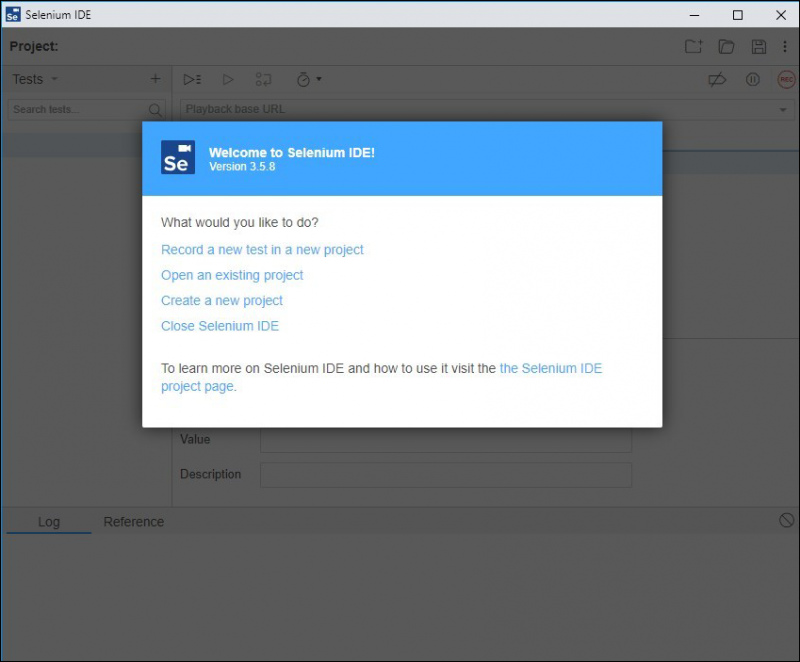
- Click Record a new test in a new project. For an existing project, click Open an existing page and select the project from its saved location.
- From the Name your new project window, provide a name for the project in the Project Name field. For example, enter PROJECT 1 in the Project Name field.
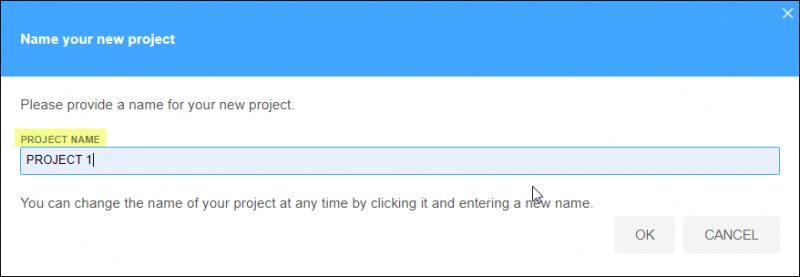
- Click OK to proceed.
- From the Set your project base URL window, enter the URL in Base URL.
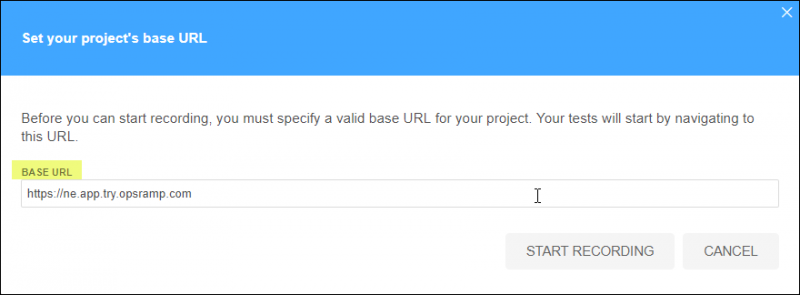
- Click START RECORDING.
- Navigates automatically to the URL entered in the Base URL field. For example: Navigates automatically to the login page of URL: https://ne.app.try.opsramp.com.
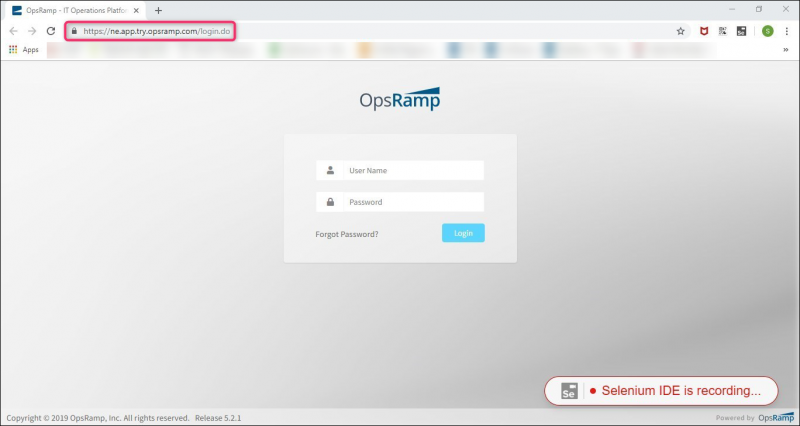
- Do all transactions on the website. The Selenium-IDE captures all actions performed on the website while recording.
- The browser window displays Selenium IDE is recording… throughout the recording process.
- Selenium IDE does not record a few commands and must be manually entered by the user.
Stop Recording
After capturing the actions on the website, stop recording the transaction in the Selenium IDE.
- Click Stop Recording icon in the Selenium IDE window.
- From Name your new test screen. enter the name of the test in TEST NAME. For example, enter TEST 1 in the TEST NAME field.
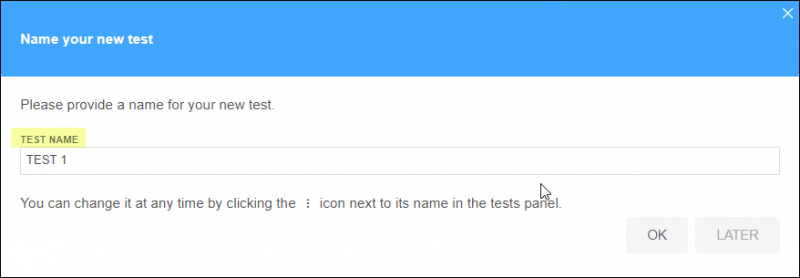
- Click OK to proceed further. Navigates to the Selenium IDE window.
- The Command, Target, and Value columns display the actions, paths, and values entered on the webpage while recording the transaction.
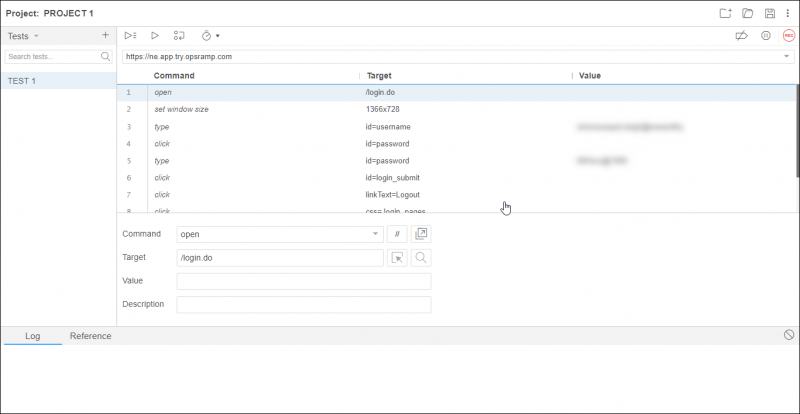
Review Recording
After the recording stops, use Run current test icon to inspect the issues in the saved recording. for any issue, use Start Recording and Stop Recording to repeat instructions.
The Log section in Selenium IDE displays the following:
- Details for each reviewed step.
- A completed successfully message after finishing the review process.
Save Recording
After the successful completion and review of the recording, save the recorded script to a local machine as a .side file.
Click Save in the Selenium IDE window. Save the file to a location in the local machine.
- Ensure to save the file as the .side file type.
- Selenium IDE saves the .side file using the project name configured during the creation of the new project.
Open the .side file from the saved location in the local machine to view the file contents.
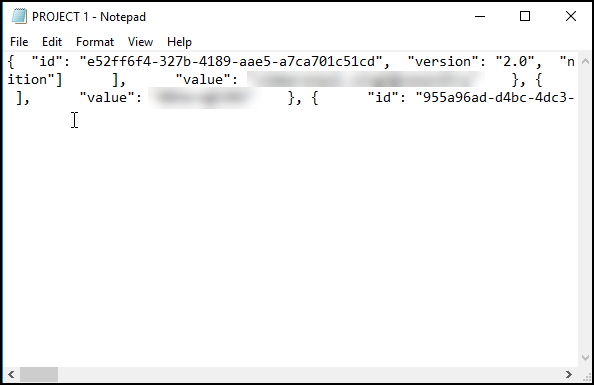
Add a Synthetic Monitor for Script
After saving the .side file, create a synthetic monitor to use the recording.
- To select your client, navigate to All Clients, and click the Client/Partner dropdown menu.
Note: You may either type your client’s name in the search bar or select your client from the list. - Navigate to Setup > Account. The Account Details screen is displayed.
- Click Integrations. The Installed Integrations screen is displayed with all the installed applications.
Note: If you do not have any installed applications, you will be navigated to the Available Integrations and Apps page with all the available applications along with the newly created application with the version. - Click + ADD on the Installed Integrations page. Note: Search for the integration either by entering the name of the integration in the search bar or by selecting the category of the integration from the All Categories dropdown list.
- Click +ADD in the Synthetics application.

- The Add Configuration screen appears. Enter the following BASIC DETAILS:
- Name: Enter the name for the configuration.
- Type: Choose SCRIPT – HTTP Synthetic Transaction type from dropdown.
- Once you select synthetic type, the SCRIPT CONFIGURATION screen appears.
Enter the following details:
| Section | Field Name | Description | Values/Example | Field Type |
|---|---|---|---|---|
| Script Configuration | Connection Timeout (seconds) | Maximum time-out to connect to the SCRIPT. |
| String |
| WebBrowserType | Option to choose a web browser type to run the HTTP Synthetic Transaction against. |
| Dropdown | |
| Time Computation | Expected Time Computation | Dropdown | ||
| Assign Credentials | Credential Set | Select the credentials from the dropdown list to access the HTTP/HTTPS Server. | Refer Create Credentials | Dropdown |
| Proxy Settings | Enable Proxy Configuration option | Refer Monitor Synthetics through Proxy Servers | Checkbox | |
| Devlop Script | Select the Script Type from the following:
| Checkbox | ||
| Configure Granular | Enabling this feature will break down the synthetic transaction into individual steps recorded during the process. Once enabled, please refer to the Configure Granular Step document. | String | ||
| Locations | Select the locations (private/public) where the monitor will run. | Location Name | Checkbox |
After configuring, navigate to Infrastructure > Resources > Web Services > Synthetic to view the metrics and graphical representations for more information.
Metrics Graphical Representation

Supported Metrics
| Metric Name | Description | Units |
|---|---|---|
| availability.down.location.count | Location Count. Number of locations where the configured host is down. | - |
| synthetic.response.time | Response time. TTime taken to complete a task in a website. | milliseconds |
Override the original credentials from the transaction in the Selenium IDE
The main purpose of using a credential set is to ensure the security of the credentials that you provide while recording a transaction from the Selenium IDE. For example, if the transaction involves logging into a website, you can override the original credentials with the assigned credential set in the Value field using a key from the Selenium IDE. The following syntax is supported when adding the credential set in the Value field:
- Username: $CREDENTIAL SET NAME.USERNAME
- Password: $CREDENTIAL SET NAME.PASSWORD
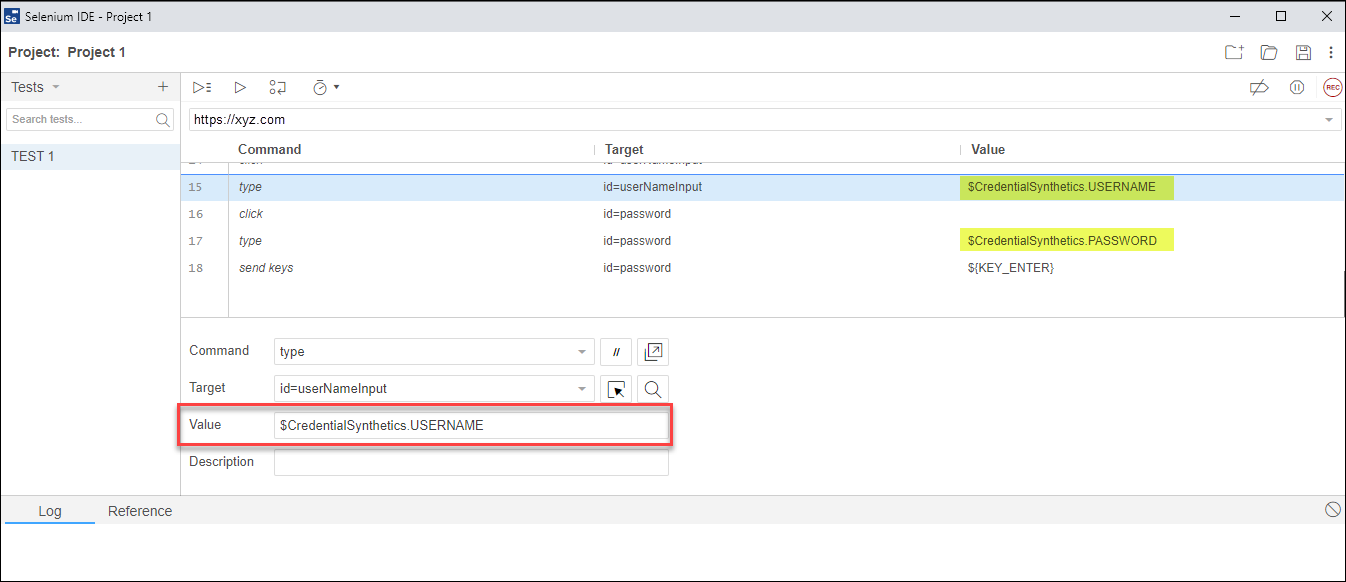
Configure Granular
Enabling this feature will break down synthetic transactions into individual steps, each represented by a unique metric.
Steps to Merge Actions:
Instead of displaying multiple granular metrics, you can combine several consecutive actions to represent a section in response graph calculations (e.g., login page, dashboard page).
- Click to Configure Granular Step.

- Select consecutive steps you want to combine.
- Click the Merge button.
- Fill the follwoing details:
- Name: Give a name to the merging step.
- Action Error Message: Enter message to display in place of RCA when this merged group fails in the transaction.
- Threshold: These thresholds are not for alerting but are used to calculate the metric synthetic_action_response_breached, which indicates the number of thresholds breached for that specific action.
- Click Save.
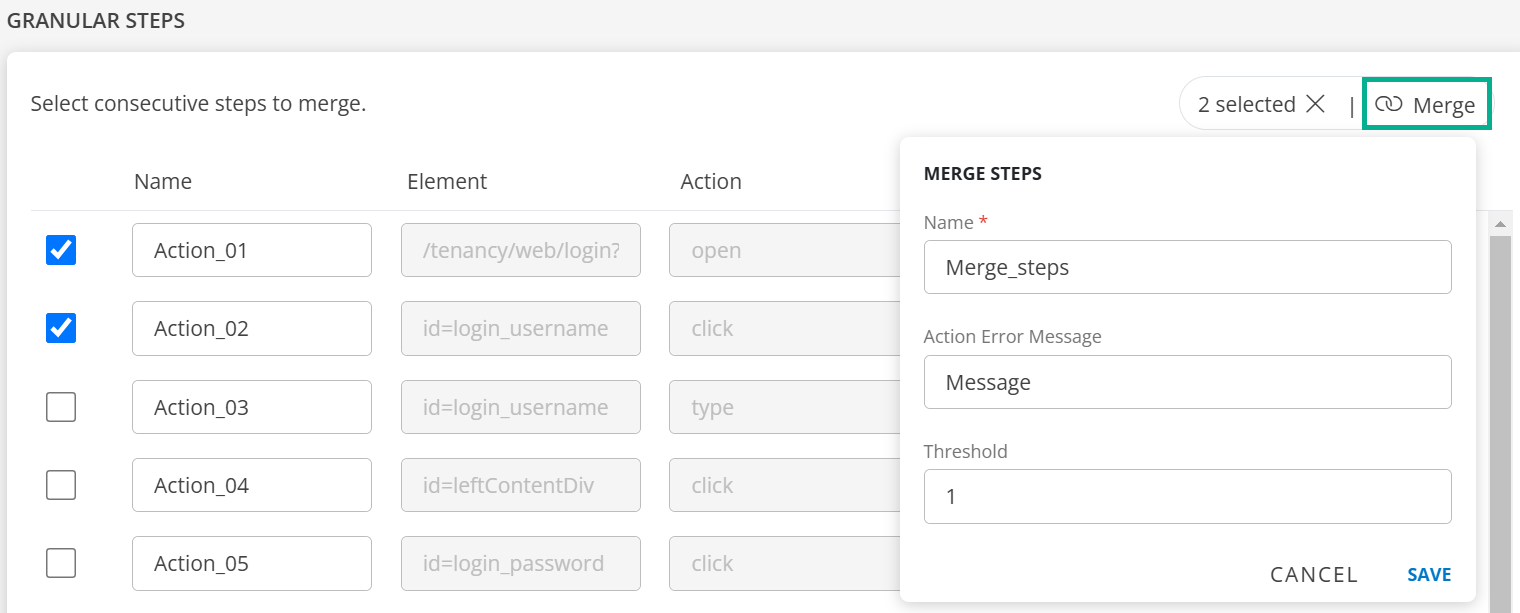
- Post Availability Metrics: For each granular step, a new metric called
synthetic_action_availability_statushas been introduced. This metric indicates the availability of each granular metric in every iteration. By selecting this option, bothsynthetic_action_availability_statusandsynthetic_action_response_breachedwill be calculated for that synthetic resource and included in Script Synthetic Performance availability reports.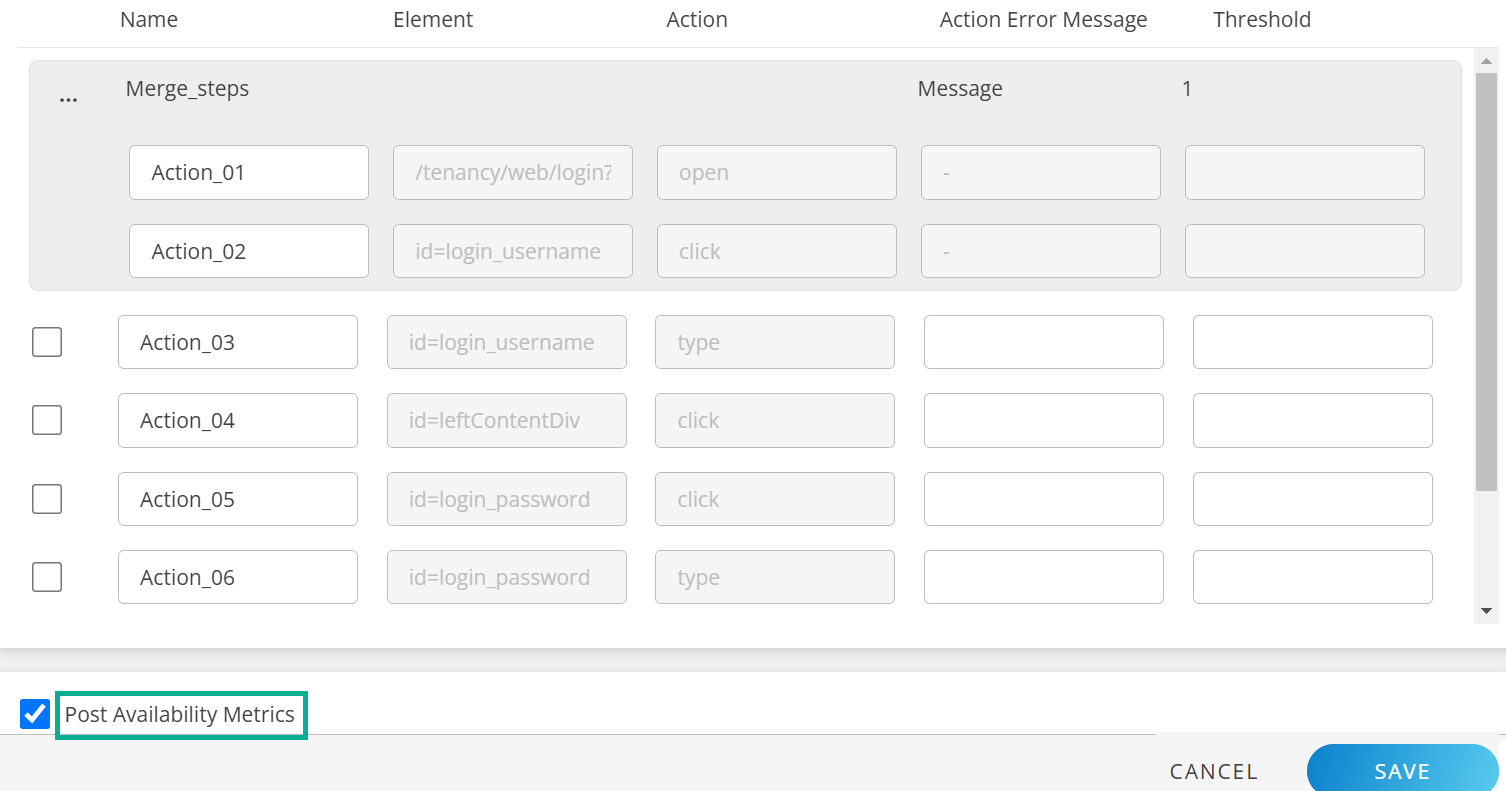
- Finally, click Save to apply the configuration changes.
Next Steps
- Assign appropriate templates for SCRIPT – HTTPS Synthetic Transaction monitor using Device Management Policy, Assign Templates, or on the resource itself.
- Check response time for each metric and configured location in the graph from the Overview section. The graph displays only up to 20 metric points. To view other metric points, select the event names from the Select Instances drop-down.